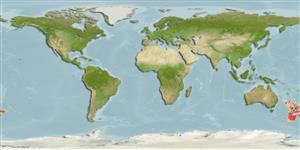Holocephali (Chimären, Seekatzen) (chimaeras) >
Chimaeriformes (Chimaeras) >
Chimaeridae (Shortnose chimaeras or ratfishes)
Etymology: Hydrolagus: hydro-, combining form of hydor (Gr.), water; lagos (Gr.), hare, i.e., “water rabbit,” probably referring to three pairs of tooth plates, which tend to protrude from the mouth like a rabbit’s incisors. (See ETYFish); bemisi: In honor of ichthyologist William E. Bemis, now at Cornell University, “longtime mentor and friend, and a leader in ichthyological research”. (See ETYFish).
Environment: milieu / climate zone / depth range / distribution range
Ökologie
seewasser bathydemersal; tiefenbereich 400 - 1100 m (Ref. 45044), usually 500 - 700 m (Ref. 45044). Deep-water
Southwest Pacific: New Zealand.
Size / Gewicht / Alter
Maturity: Lm ? range ? - ? cm
Max length : 112 cm TL Männchen/unbestimmt; (Ref. 45044)
Kurzbeschreibung
Morphologie | Morphometrie
Pale brown coloration fading to white ventrally. Dorsal fin spine reaching to origin of second dorsal fin when depressed; elongated second dorsal fin not indented along its length. Horizontal and hyomandibular lateral line canals sharing a common branch. Caudal filament long and stout (Ref. 45044).
Oviparous (Ref. 205). Eggs are encased in horny shells (Ref. 205).
Life cycle and mating behavior
Geschlechtsreife | Fortpflanzung | Ablaichen | Eier | Fecundity | Larven
Didier, D.A., 2002. Two new species of chimaeroid fishes from the southwestern Pacific Ocean (Holocephali, Chimaeridae). Ichthyol. Res. 49(4):299-306. (Ref. 45044)
IUCN Rote Liste Status (Ref. 130435)
Bedrohung für Menschen
Harmless
Nutzung durch Menschen
Mehr Information
ReferenzenAquakulturAquakultur ProfilZuchtlinienGenetikElectrophoresesVererbbarkeitKrankheitenVerarbeitungNutrientsMass conversion
Tools
Zusatzinformationen
Download XML
Internet Quellen
Estimates based on models
Preferred temperature (Ref.
123201): 5.4 - 9.5, mean 7.1 °C (based on 125 cells).
Phylogenetic diversity index (Ref.
82804): PD
50 = 0.5000 [Uniqueness, from 0.5 = low to 2.0 = high].
Bayesian length-weight: a=0.00380 (0.00194 - 0.00745), b=3.09 (2.91 - 3.27), in cm total length, based on LWR estimates for this species & (Sub)family-body (Ref.
93245).
Trophic level (Ref.
69278): 3.9 ±0.6 se; based on size and trophs of closest relatives
Widerstandsfähigkeit (Ref.
120179): niedrig, Verdopplung der Population dauert 4,5 - 14 Jahre. (Assuming Fec <100).
Fishing Vulnerability (Ref.
59153): High to very high vulnerability (67 of 100).
